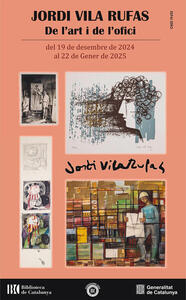
Jordi Vila Rufas: Art and Office / Exhibitions / Visit us / Start

Date Start: 12/19/2024 Final date: 01/22/2025
Place:
Zero space
Hours:
Monday to Friday, from 9 a.m. to 8 p.m. Saturdays, from 10 a.m. to 2 p.m.
Commissariat:
Roser Icenser Brufau and Xavier Soler Ávila. Graphic unit.
The first years. Academic drawings – Documents
Religious altarpieces – Documents
Virals and mural painting – Documents
Individual Exhibitions – Documents
Jordi Vila Rufas (Barcelona, 1924 – 2011) belongs to a lineage of artists. The father – and also a teacher -, Joan Vila ‘d’Ivoi’, knew how to stimulate the children, Jordi, and his brother Francesc d’Assís (CESC) – with whom he collaborated several times – in his first You pass as artists. The two brothers studied at the Massana School, where Jordi has been a student since 1941, and later a teacher, from 1952 and until 1990.
Designed by Josep F. Ràfols as a painter and altarpiece, Vila Rufas has legacy to us a large amount of work in both civil and religious buildings. As an altarpiece, he stood out with works that technically enthrone with the Gothic tradition – such as the applications of gold or silver bread or the brunyits – that transports his style through the combination with modern techniques. As a painter, he has left us in many buildings throughout Catalonia. However, he should also emphasize his work as an illustrator and designer, both advertising and reminder and other ephemeral and decorative objects.
His style belongs to what has been defined as the new figuration of the mid-twentieth century, that is, a figurative current-or abstract-figurative-contemporary to the second abstract avant-garde with which he coexisted. A figuration that he conveyed from sketched and stylized expressionism, as well as geometrizing.
Heir of artistic trades of the Massana School in a few years when some Noucentista temper is still dragged on in teaching, their relationship with the traditio He expressed it with the taste for use in his works of the golden ratio as a compositional frame. And in an age when La Massana approached what was understood as a school of Fine Arts, Vila Rufas stated ‘We are a school of trades, not a literature school‘, thus giving value to the tradition and the artistic trade, in which it introduced differential elements or of some approach to modernity.
Important works in his career are the altarpieces of the church of Sant Joan de Vilassar (1948-1954), the altarpieces of Sant Cugat (1953) or the chapel of the Adela de Trenquelleon school in Barcelona (1960). He exhibited in various Barcelona rooms and contests, such as the Vayreda Room, Jaimes, the May Halls, etc., and won awards in some collective samples, such as the 1947 National Decorative Arts Exhibition. It was also present in several Spanish cities such as Madrid and Salamanca, and from Paris he was part of the Groupe Reflets. He also participated in several groups in New York and Chicago in 1960.
The selection of pieces we present allows us to have a bird view of the different slopes of his work, basically from prints, ephemeral materials, sketches and previous drawings, which give us an approach to the creative process. of an artist who deserves to be vindicated and studied as one of the representatives of the new Catalan figuration of the 20th century.








